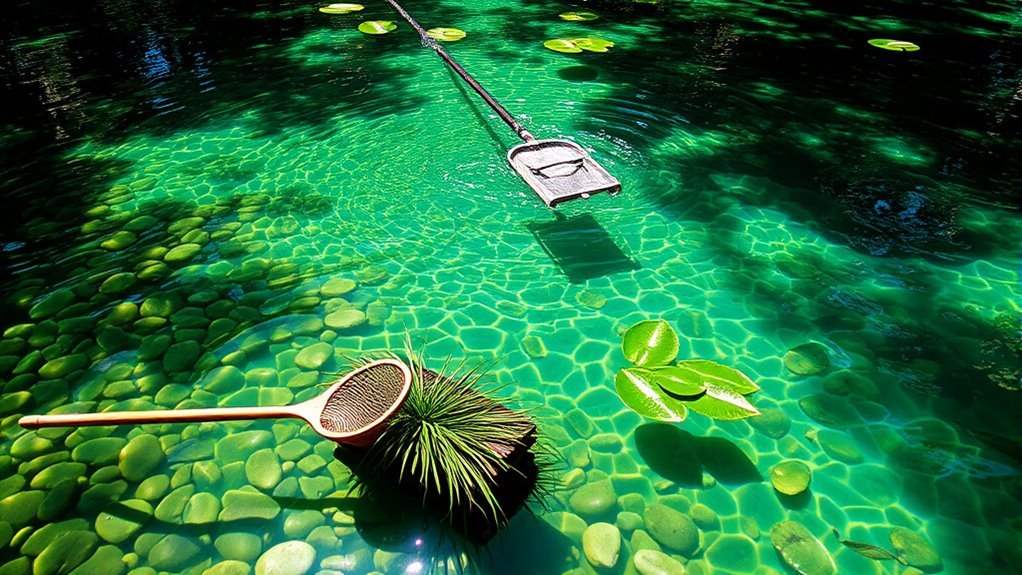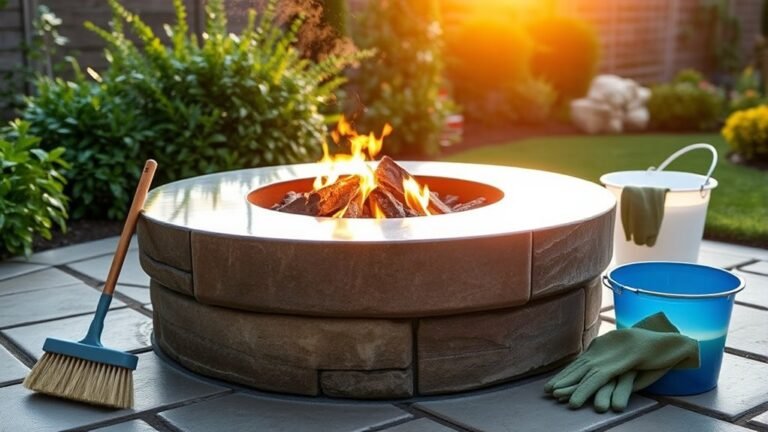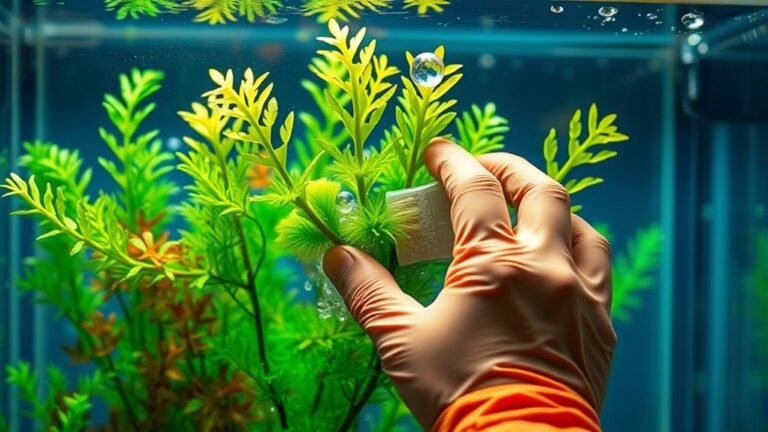How to Keep a Pond Clean for Swimming
To keep your pond clean for swimming, start with regular maintenance. Remove debris weekly and use a skimmer to capture floating contaminants. Test the water for pH and ammonia levels to guarantee a healthy balance. Introduce beneficial bacteria to break down organic waste and monitor algae growth closely. Implement proper safety measures, like designated swimming areas, and maintain water circulation. For effective long-term results, explore various strategies and tools that can enhance your pond’s cleanliness and enjoyment.
##
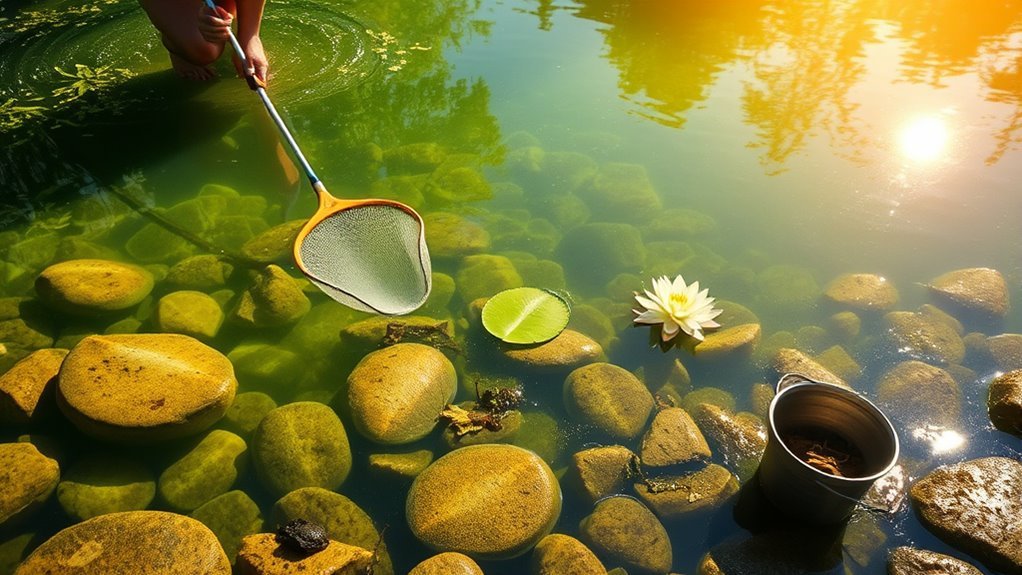
Maintaining a clean pond for swimming is crucial for ensuring a safe and enjoyable experience, and understanding the various factors that influence water quality is key to achieving this goal. In this article, we will explore essential elements such as nutrient balance, algae control, and effective filtration systems that contribute to a healthy pond environment. By addressing common challenges like excessive algae growth and monitoring important water parameters, you will learn how to implement practical solutions for improving your pond’s health. Additionally, we will discuss the benefits of aeration systems and natural vegetation in enhancing water quality. With this comprehensive guide, you will gain the knowledge needed to create a pristine swimming pond that prioritizes safety and clarity.
Preparation For Cleaning
Before diving into the actual cleaning process, it’s vital to gather the necessary tools and materials to guarantee an efficient and thorough job. Start by evaluating your pond’s current state, as this will inform your pond maintenance strategy. Check the water quality; good clarity and balance are essential for swimming safety. You’ll need basic supplies like a net, a skimmer, and appropriate containers for debris removal. Additionally, consider water testing kits to monitor levels of pH, ammonia, and other significant parameters. Planning your approach allows you to tackle specific issues effectively, ensuring a clean and inviting swimming environment. By preparing adequately, you’re setting the stage for successful cleaning and improved water quality in your pond.
Tools and Chemical Required
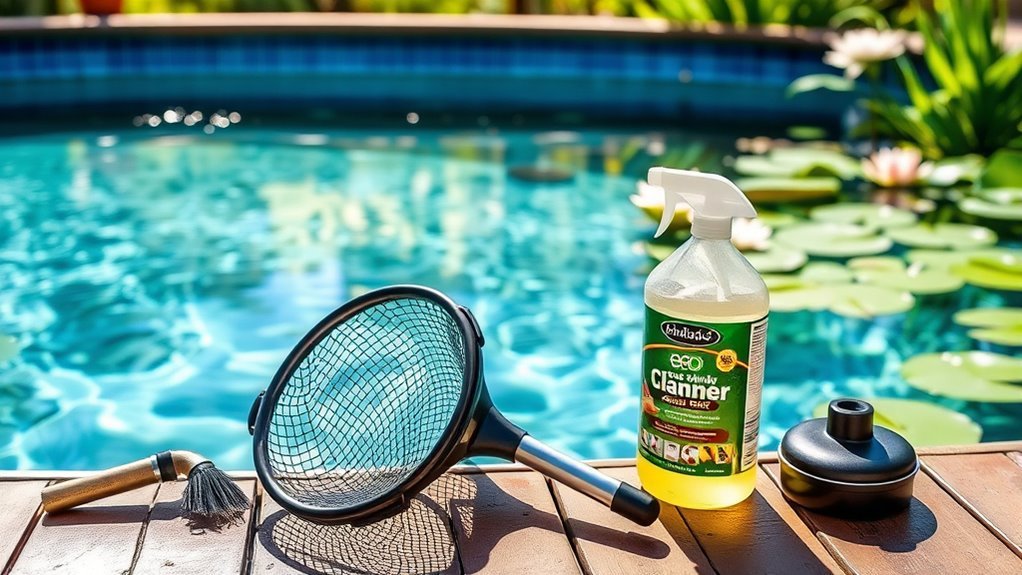
Having gathered your tools and assessed your pond’s condition, it’s time to focus on the specific equipment and chemicals that will help maintain a clean swimming environment. Effective pond maintenance requires a strategic selection of cleaning supplies. Here’s a quick reference table to guide you:
| Tools/Chemicals | Purpose |
|---|---|
| Pond Vacuum | Removes debris and sludge |
| Algaecide | Controls algae growth |
| Water Test Kits | Monitors pH and clarity |
Utilizing these essential items guarantees your pond remains inviting and safe for swimming. Invest in quality cleaning supplies to save time and effort in the long run. A well-maintained pond can enhance your enjoyment and provide a revitalizing retreat.
How to Clean:
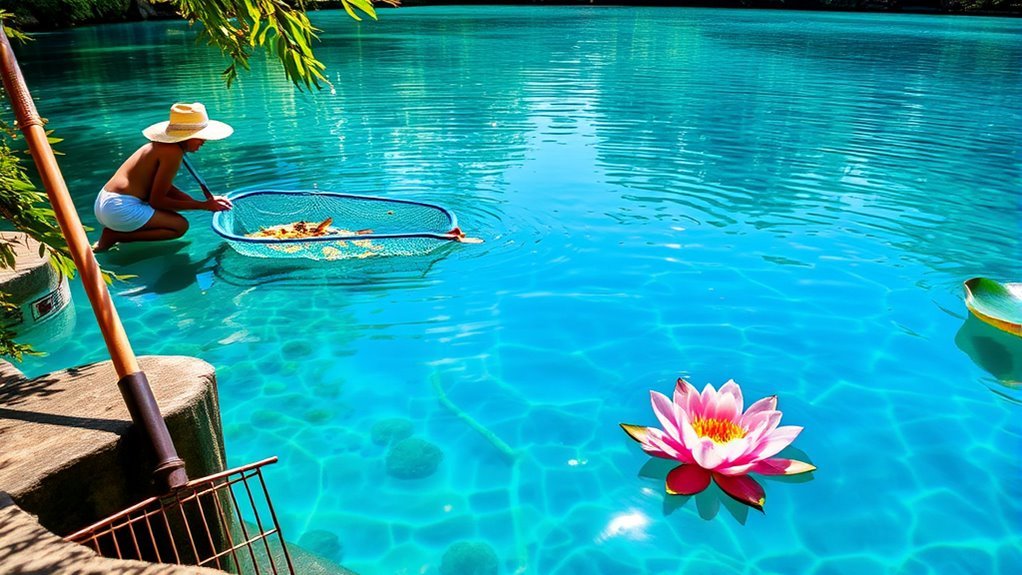
Step 1: Regular Pond Maintenance
- Remove Debris and Leaves: Regularly inspect the pond surface for fallen leaves, twigs, and other debris. Use a net or rake to gently collect and remove these materials to prevent them from decomposing and polluting the water.
- Check for Water Clarity: Observe the water clarity regularly. If it appears murky or discolored, it may indicate a buildup of organic material or algae.
Step 2: Skimming the Surface
- Utilize a Skimmer: Use a skimmer to capture floating algae, leaves, and other contaminants. Make sure to skim the surface at least once a week, especially during the fall when leaves are more likely to accumulate.
- Dispose of Collected Waste: After skimming, dispose of the collected debris properly to prevent it from re-entering the pond.
Step 3: Introduce Beneficial Bacteria
- Choose the Right Bacteria: Look for beneficial bacteria products designed for ponds, which help in breaking down organic material.
- Apply Regularly: Follow the manufacturer’s instructions for dosage and frequency. Typically, applying bacteria once a month can help maintain a balanced ecosystem and reduce nutrient levels that promote algae growth.
Step 4: Maintain Filtration System
- Inspect the Filtration System: Regularly check the filtration system to ensure it is functioning efficiently. Look for any signs of wear or blockages.
- Clean Filters: Rinse or replace filters as needed to enhance water clarity and ensure optimal performance. A clean filter will significantly improve the quality of the water.
Step 5: Manage Algae Blooms
- Monitor for Algae Growth: Keep an eye on the pond for any signs of excessive algae blooms, such as green, murky water or scum on the surface.
- Apply Algaecides Sparingly: If algae blooms persist, consider applying algaecides. Use these products sparingly to avoid disrupting the ecological balance of the pond. Always follow the application instructions carefully.
Step 6: Routine Water Testing
- Test Water Regularly: Use a water testing kit to monitor the pH and nutrient levels of the pond water at least once a month.
- Adjust as Needed: Based on the test results, make necessary adjustments to maintain optimal water quality. This could involve adding pH balancers or adjusting feeding practices for fish.
Safety Consideration
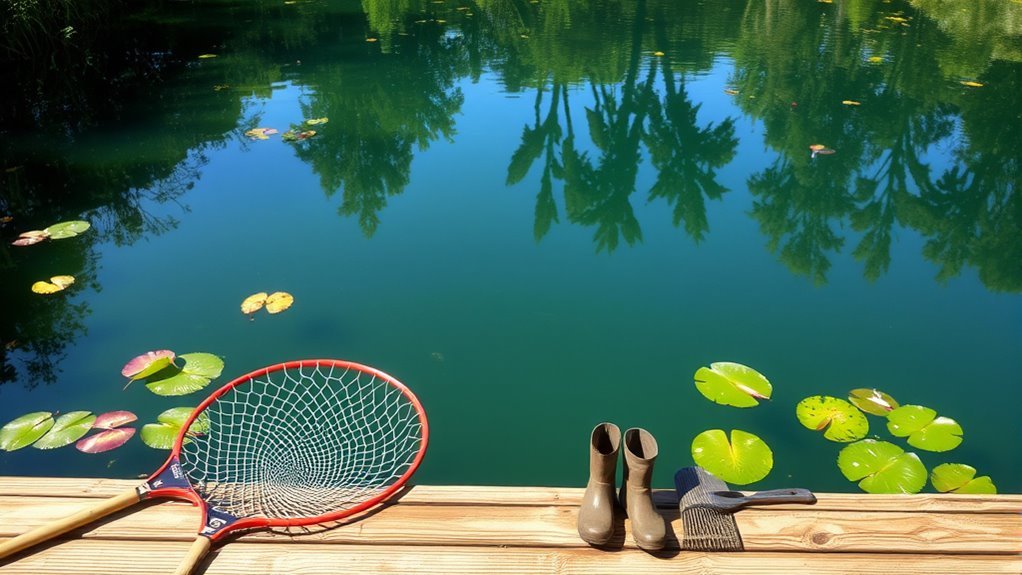
Maintaining a clean pond for swimming isn’t just about aesthetics; it also involves essential safety considerations. First and foremost, water quality is vital. Regularly test for contaminants, pH levels, and bacteria to guarantee the water remains safe for swimming. Poor water quality can lead to health risks, such as skin irritations or infections.
Additionally, be mindful of the pond’s depth and any submerged hazards like rocks or debris, which can pose risks during swimming. Installing a designated swimming area can help keep swimmers safe and minimize accidents. Finally, make certain to monitor swimmers closely, especially children, to prevent drowning. By prioritizing water quality and swimming safety, you can create a serene yet secure environment for everyone to enjoy.
Tips to keep clean for long time
To guarantee your pond remains clean for the long haul, implementing a combination of proactive measures is key. Start by ensuring proper water circulation; install a fountain or a pump to keep water moving, which prevents stagnation and promotes oxygenation. This not only benefits aquatic life but also helps in algae control. Regularly remove debris like leaves and organic matter, as these can feed unwanted algae growth. Consider adding beneficial bacteria to break down waste and enhance water clarity. Additionally, using aquatic plants can naturally absorb excess nutrients, further controlling algae. Finally, monitor water quality frequently to catch any imbalances early. By staying vigilant and proactive, you’ll enjoy a clean, inviting pond for years to come.
Frequently Asked Questions
How Often Should I Test the Water Quality?
Water’s the essence of life, shimmering like a promise. You should test the water quality at least once a week, especially during hot months when it’s more susceptible to changes. Focus on key quality parameters like pH, ammonia, and chlorine levels. Regular water testing helps maintain a safe environment, ensuring your pond remains a rejuvenating escape. Remember, consistent checks empower you to enjoy that freedom, knowing your pond’s health is in good hands.
Can Fish Remain in the Pond During Cleaning?
Yes, fish can remain in the pond during cleaning, but it’s essential to use gentle cleaning techniques to guarantee their survival. Avoid harsh chemicals or disturbing the sediment too much, as this can harm the fish. Instead, opt for natural methods, like manual debris removal or using a net to catch excess algae. Monitor the water quality closely during and after cleaning to keep your fish safe and thriving in their environment.
What Natural Methods Can I Use for Cleaning?
Imagine your pond as a small ecosystem, thriving with life. To clean it naturally, consider using aquatic bacteria that break down organic waste, acting as nature’s cleanup crew. You can also install natural filtration systems, like plants, that absorb nutrients and improve water quality. These methods not only preserve the pond’s harmony but also grant you the freedom to enjoy a clean, vibrant swimming environment without harsh chemicals.
Are There Specific Plants That Help Keep the Pond Clean?
Yes, there are specific plants that can help keep your pond clean. Water filtering plants, like cattails and water lilies, absorb excess nutrients and provide shade, reducing algae growth. Beneficial aquatic flora, such as duckweed and anacharis, also play an essential role in maintaining water quality by oxygenating the water and offering habitat for beneficial microorganisms. Incorporating these plants not only enhances the ecosystem but also creates a more inviting environment for swimming.
How Do I Prevent Algae Growth in the Pond?
To prevent algae growth in your pond, think of it like weeding a garden. If you let one weed take root, it can quickly spread. Focus on controlling nutrient levels; avoid excess fertilizers, and consider adding beneficial bacteria to compete with unwanted algae types. Regularly remove debris and consider shading with aquatic plants to limit sunlight. Implementing these prevention techniques can help you maintain a clear, inviting pond that truly feels like your own oasis.
